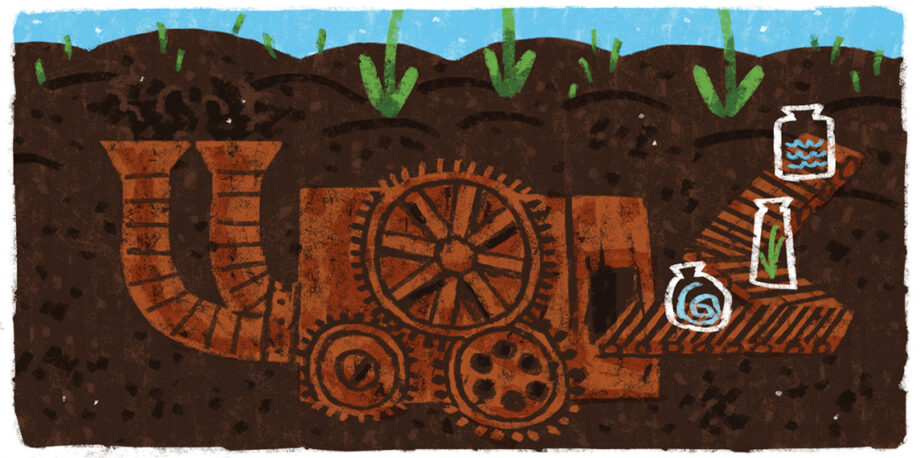July 20, 2015 — The United Nations’ International Year of Soils is hardly a media darling. Maybe it’s because many people are like me, who recall Mom’s words: “Take off your shoes! Don’t bring dirt into the house!” With all the challenges in the world today, why would we recognize soils?
Simply put, soils are literally the foundation that humanity stands on. Shrugging off the importance of this meter-thick skin covering our planet is like shrugging off the importance of the air we breathe. Without healthy soils, we would not be here.
Here’s why: Soil provides the structure and nutrients needed to grow our food. It stores water that quenches the thirst of ecosystems, agriculture and humans. It houses the largest stock of carbon on land (perhaps double or quadruple the amount stored in all vegetation), keeping the climate from warming even faster. It provides the foundation for habitat that supports all of life on land — including diversity in the soil itself (in some regions, just a pinch of soil contains more microbes than there are people on Earth). In short, soil plays an essential role not only in feeding humanity but in sustaining the living things that produce the oxygen we breathe and cleansing the water we drink. In other words, soil keeps our planet habitable.
But many of soils’ characteristics that create these benefits are being degraded. In many regions of the world, soil has become polluted or saline to the point of being toxic to plants, or has been paved over. In other places rich topsoil is being eroded from water, wind and plowing; each year, between 10 and 30 gigatons of soil is lost through erosion. To put that in context, all the concrete in the biggest structure on earth, the Three Gorges Dam, adds up to 0.07 gigatons.
Rarely do our tech fixes do what nature does as accurately, efficiently or effectively.
Once topsoil is removed a vicious cycle begins in which nutrients are depleted, reducing the ability of plants to grow, because it’s difficult for water to soak into the ground and for soils to hold nutrients. More exposure to the sun’s heat causes the organic matter to break down faster, releasing carbon dioxide into the air and further reducing soil fertility.
There are some technological fixes to these problems, but rarely do our tech fixes do what nature does as accurately, efficiently or effectively. In natural systems (including agricultural systems that mimic them), organic matter is continually added from dead animals and vegetation, helping soils store water, nutrients and carbon. In natural systems, nutrients are continually recycled, inputs and outputs are balanced, and very little is wasted.
So, what do we need to do to protect this often-ignored but life-giving resource? First, we need to manage fertilizer and manure wisely. Crops typically only take up about half of the nutrients that are applied, so farmers must only apply what is needed by the plants but not more than the soil can retain. Second, we need to mimic nature’s strategy for preventing erosion by planting cover crops or leaving crop residues on the field that keep the ground covered throughout the year and thus reduce soil exposure to wind and rain. Third, we need to strategically plan urban development and transportation corridors so as to protect our richest and most productive soils.
We must stop considering “soil” a dirty word and remember that the food we eat and water we drink can be traced back to it.
Such management practices provide short-term gains of producing food today but also provide the foundation of well-being for future generations.
We must stop considering “soil” a dirty word and remember that the food we eat and water we drink can be traced back to it. Businesses should adopt soil sustainability guidelines that follow principles such as the ones mentioned above, similar to no-deforestation commitments. And local and national governments should provide incentives, policies and education that prioritize soil conservation.
On an international level, the United Nations General Assembly is planning to set into place this fall a new set of sustainable development goals for eliminating hunger and extreme poverty that will catalyze future actions of development banks, nations, nonprofit groups and many others. Agriculture provides a key pathway out of poverty and hunger in many rural areas where farmers work small plots of land. Healthy soil should be central to the SDG discussions, both the defined outcomes and the path forward, because ensuring those farmers are working on — and with — healthy soil will mean they are reaping all the benefits it provides. Including soil health in the SDGs would provide the foundation for enduring benefits for all people.
Soil is one of the most important resources on our planet, and we have ignored it too long — to our own peril. The most important thing that can happen is a change in mind-set that recognizes soil is not dirt. It’s life beneath our feet. ![]()
Editor’s note: The views expressed here are those of the author and not necessarily of Ensia. We present them to further discussion around important topics. We encourage you to respond with a comment below, following our commenting guidelines, which can be found here. In addition, you might consider submitting a Voices piece of your own. See Ensia’s “Contact” page for submission guidelines.
Ensia shares solutions-focused stories free of charge through our online magazine and partner media. That means audiences around the world have ready access to stories that can — and do — help them shape a better future. If you value our work, please show your support today.
Yes, I'll support Ensia!
